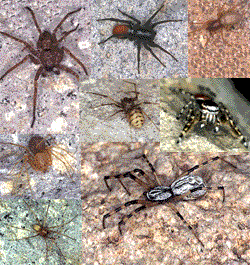
http://aridspiders.nmsu.edu
The arid Southwest can be defined as being composed of the states of Arizona and New Mexico, and part of the states of California and Texas and possibly Utah and Nevada. The northern parts of the Mexican states of Baja California Norte, Sonora, and Chihuahua could also be included in this region. The current work is, however, centered on the Arizona-New Mexico-Trans-Pecos Texas part of the arid Southwest, although it should be useful in the other mentioned areas.
The arid Southwest so defined includes the northern parts of the Sonoran and Chihuahuan Deserts, except for the extreme western part of the former in California, as well as a small portion of the Mojave and Great Basin Deserts. In reality it could be argued that the extensions of the two deserts in Mexico should be included and the far northern parts of Arizona and New Mexico excluded.
However the fauna south of the United States border is even less defined than that to the north and that a complete treatment of the faunas of Arizona and New Mexico as political units is necessary for regulatory purposes, as well as for public use. It is helpful to keep in mind that such treatments are inherently artificial and really do not reflect the true picture of ecosystems any more than do bird or wildflower manuals for given political units.
Even with these limitations, the fauna is huge, well over 1000 species (1085 as of December 11, 2020). This current study is an attempt to describe this fauna for the use of arachnologists, entomologists, extension workers, naturalists and private citizens, who might want to know whether the spider they found in their house is venomous or wish to encourage the pest-catching activities of spiders in their house or garden.
Richard Carter of Phoenix, AZ, sent in additional Linyphiidae records from his work with Don Lowrie and we thank him for these. We also want to thank Richard Vetter of the University of California - Riverside, for his generous help in revising the "Toxic Spiders" section (Changed from "Venomous Spiders." ) The other sections have been revised as well to include a complete Literature Cited section as some of the references listed in these sections were not in the general literature review. We hope that this will make the site more useful.
Note: The Spiders Of The Arid Southwest major editing is finished. I will continue to modify it as data becomes available. Any new data would be most gratefully received.
Further Note #1: I (DBR) have now made the necessary changes in the list (with the help of Connie Padilla) to include three new families and merged one family (Zoridae) with the Miturgidae, to conform to recent changes (Ramirez 2014). I have also updated the Linyphiidae. If any errors are noted, please notify me at rdavid@nmsu.edu. Additional changes were necessary because of the moving of the Tengellidae and Zorocratidae into the Zoropsidae (Polotow,et al., 2015) and the revision of the theraphosid tarantula genus Aphonopelma by Hamilton, et al. (2016).
Further Note #2: I (DBR) am in the process of adding the newly described family Myrmecicultoridae (Ramírez, et al. 2019) and recent changes in the genus "Sitticus."
David B. Richman, College Professor Emeritus
Department of Entomology, Plant Pathology and Weed Science
Las Cruces, N.M. 88003
Phone: 575-646-3225 (main office)
Fax: 575-646-8087
Email: rdavid@nmsu.edu